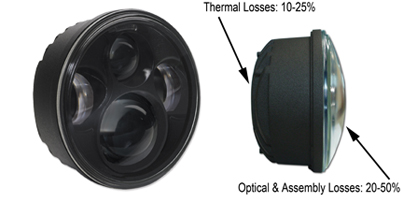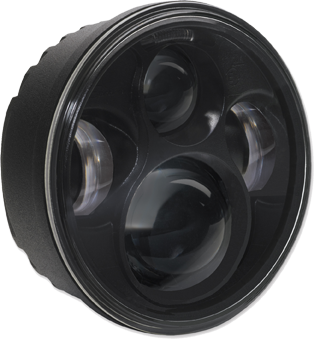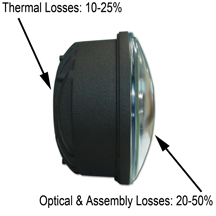
Understanding the difference between raw and effective output is critical
By Ryan Mayrand

In LED lighting technology, Lumens are the standard unit of measure used to describe how well a light source will illuminate objects. Because operators typically rely on output to evaluate LED lights, many manufacturers prominently tout high lumen numbers on product literature. What they fail to clarify is these big numbers are actually the raw lumen output as opposed to the effective lumen output.
Raw lumen is theoretical
The raw lumen output of a light is actually a theoretical value rather than the actual measure of useful output of light. Manufacturers calculate the number of raw lumens by multiplying the number of LEDs in a light by their maximum output rating. For example, if a light uses 10 LEDs with a maximum output rating of 100 lumens, the raw lumen output would be 1,000 lumens (10 x 100 = 1,000). No photometric testing is necessary to come up with this number. The raw lumens metric is unreliable in evaluating LED lights. It does not take into account real world factors that can decrease the light output as much as 75 percent.
A couple of major factors contribute to decreases in light output. First are thermal losses. The hotter LEDs get, the less light they produce. LEDs powered for longer and longer periods of time typically heat up. In fact, it is not uncommon for LEDs to reach temperatures of over 212ºF (100ºC). So, it stands to reason that the light output of an LED when initially lit is cooler than when it has been on for 30 minutes and decreases under the heat.
LED manufacturers calculate their maximum output ratings by measuring the light output of the component after 25 milliseconds — the equivalent in duration to the burst of a flash bulb. Any operator who uses LED lighting for longer than 25 milliseconds at a time is going to see light output that is less than the raw lumen value. How much less depends on the thermal management of the light, but the loss is typically in the neighborhood of 10 to 25 percent.
Most raw lumen output figures also fail to take into account the current used to drive the LEDs. Driving a higher current through an LED will produce more light, but it also makes the LED hotter, which creates thermal losses and shortens the life of the product. When light travels through or reflects off materials, such as optics, lens and reflectors optics, it loses some of its intensity due to inherent losses internal to the material. Losses also occur at the surface as the light travels from air through the lens and back. Any light from optics, reflector optics or a lens will unavoidably fall victim to these losses. Couple these optical losses with assembly variations, and the result is an additional 20-50 percent decrease in light output that the raw lumen figure does not account for.
Effective Lumens
Raw lumens are a theoretical measure that fails to account for real world losses. The effective lumen output is an actual measurement of light output that does take into account all real world losses noted above. Measuring the effective lumen output of a light requires the use of high-tech photometry equipment. Because of the cost and expertise involved in conducting photometric testing, some manufacturers opt to cut corners and simply use the theoretical raw lumen numbers. This makes an apples-to-apples comparison between lights very difficult, resulting in consumers receiving less useable light than actually advertised.

Here is a practical example: LED light No. 1 has an output rating of 2,000 raw lumens and 1,000 effective lumens. LED light No. 2 has an output rating of 3,000 raw lumens, but only 500 effective lumens. Based solely on raw lumens, No. 2 would be the clear choice. However, turn both lights on and light No. 1 would be twice as bright as light No. 2 because it has the higher effective lumen output.
It takes special engineering and manufacturing processes to minimize losses. Many lights may only produce an effective lumen output that is 25 percent of the raw lumen output, but many of ours have effective lumen outputs of as much as 50 to 60 percent. For example, the Model 8630 has a raw lumen output of 1,200, but an effective lumen output of 600-650.
To get the entire picture, J.W. Speaker encourages operators to challenge manufacturers and lighting sales reps to provide both the raw and the effective output numbers.
Ryan Mayrand is with the J.W. Speaker Corporation, Germantown, WI.
